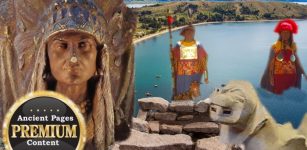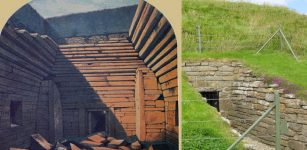Isotope Analysis Helps Tell The Stories Of Aboriginal People Living Under Early Colonial Expansion
Conny Waters - AncientPages.com - In 2015, Gkuthaarn and Kukatj community members of Queensland's Gulf Country invited us to excavate, analyze, and rebury the skeletal remains of eight young Indigenous people who died near the town of Normanton in the late 1800s.
The remains were acquired by Walter Roth (1861–1933). Roth was a medical doctor, anthropologist, and the first Northern Protector of Aboriginal people.
Gkuthaarn and Kukatj rangers reburied the remains in the Normanton Aboriginal Cemetery in 2015. Credit: Shaun Adams et al.
He eventually sold the remains to the Australian Museum in Sydney, which held them for almost a century before repatriating them to the Traditional Owners in the 1990s.
The remains were reburied, but later exposed by erosion—which prompted Gkuthaarn and Kukatj community members to invite us to collaborate with them.
In research published in Archaeologies, we show how bioarchaeological techniques have helped shed light on the experiences of these young Indigenous people who were displaced by European colonization.
Unfortunately, we only know the name of one of the eight individuals—a young woman named Dolly. Roth's records indicate Dolly was a member of the Gkuthaarn and Kukatj People, and was working at the police barracks (shown in the banner image) in the town of Cloncurry, about 382km south of Normanton, when she died.
Driven from their lands
In 2018, we published a study that showed these individuals had experienced nutritional stress and, in some cases, syphilis. These findings are consistent with other evidence relating to the experience of Aboriginal people living on the Gulf Country during colonial expansion.
Archaeological data and historical documents indicate Aboriginal people on the Gulf Country lived as foragers until the mid-1800s, when their lands were occupied by Europeans and stocked with cattle. The cattle depleted resources that were critical for a foraging lifestyle, and conflict ensued.
As a result of the violence and loss of resources, many Aboriginal people on the Gulf Country became refugees in their own land. They had little choice but to move into camps on the fringes of towns such as Normanton. These camps were overcrowded and unhygienic, and many occupants died from infectious diseases as a result.
We spoke to several Gkuthaarn and Kukatj people during the course of our research. One senior person expressed feeling relief when the remains were safely retrieved and reburied:
Maps showing the location of Normanton relative to the Gulf Plains region and Cape York. Credit: Shaun Adams et al
"[Researchers] put a tarp over and dug it [the remains] up real steady. [They were] fragile from the sun […] We felt like we was just welcome [by the spirits of the people connected with these remains], like they wanted to get reburied. [We] just had that feeling they wanted to get reburied; was a couple of times they had been exposed."
Insight into displacement, disease and diet
In our recent study, we analyzed strontium, carbon, and oxygen isotopes from the teeth of six of the eight individuals.
Measuring isotope ratios in human bones and teeth can reveal information about an individual's diet and geographical movements prior to their death. When we compare strontium isotope values from tooth enamel to an isotope map (called an "isoscape") constructed for this project, we can see where the six individuals grew up.
Dolly's strontium value suggests she grew up near the Gulf of Carpentaria. This is consistent with Roth's suggestion that Dolly was a member of the Gkuthaarn and Kukatj People, as their traditional territory extends to the coast. The strontium results for the other individuals suggest they grew up some distance to the east or northeast of Normanton.
Carbon isotope results indicate that in their early years, all six individuals had diets dominated by tropical plants and/or marine foods. However, Dolly's carbon value suggests her diet was especially high in such foods. This is again consistent with her having lived near the Gulf of Carpentaria when she was young.
The oxygen isotope results we obtained are also high when compared to international samples. We suspect these elevated values can be explained by a combination of the environmental conditions in the Gulf Country, and the effects of infectious diseases that spread into the region with European settlers.
Based on the formation times of Dolly's tooth samples, and her strontium and oxygen values, we estimate she moved from the Gulf of Carpentaria to the Cloncurry area sometime between the age of 2.5 and 10. Our analyses also suggest she was a young adult when she died.
These assessments are in line with Roth's reports from the Gulf Country, which state that Indigenous girls were often taken from their families and made to work for Europeans, and that it was common for such individuals to succumb to diseases early in life.
Speaking on the findings, one Gkuthaarn and Kukatj person told us:
"I am sad to learn of our people getting horrible diseases and, with the study completed, these were young people who left behind such a sad story that needs to be told so non-Indigenous people, not just throughout Australia but particularly in our region, know and understand that these traumas still impact on our people 120 years later."
The Voice
Combined with historical documents and information from contemporary Gkuthaarn and Kukatj People, our results provide new individual-level insight into the devastating impact of European colonization on Aboriginal people of the Gulf Country.
Australians are currently debating a constitutional amendment to create an Aboriginal and Torres Strait Islander Voice to Parliament. The proposed amendment is a key recommendation of the Uluru Statement from the Heart. Another key recommendation is that of "truth-telling" about the experiences of Aboriginal people during European colonial expansion.
Science can't tell us whether the Voice is the correct course of action. Yet our findings about these individuals—whose remains we have been honored to analyze—reveal that scientific work conducted with and by First Nations people has an invaluable role in the process of truth-telling.
We hope such work will help reveal more truth of the experiences of those rendered voiceless by the violence of colonization. As one Gkuthaarn and Kukatj person explained:
"My old grandmother was one of those people who said they was horrible and didn't want to repeat it [i.e. they did not want to tell accounts of colonial violence to subsequent generations], but I believe it should be repeated [to] help us understand more about what really happened. People [are] just listening to one side of it. You've got people who say Aboriginals just live off the welfare, but there was a reason why that happened. Aboriginal people fought for this country. You've got people who say you've gotta get over that [colonial violence], but what I say is: lest we forget."
Authors: Shaun Adams, Archaeologist, Griffith University; David McGahan, Visiting Researcher, Griffith University; Mark Collard, Canada Research Chair in Human Evolutionary Studies, and Professor of Archaeology, Simon Fraser University; Michael Westaway, Australian Research Council Future Fellow, Archaeology, School of Social Science, The University of Queensland; Richard Martin, Senior lecturer, The University of Queensland
This article is republished from The Conversation under a Creative Commons license. Read the original article.![]()
More From Ancient Pages
-
 Catequil – Inca God Of Thunder And Lightning Who Predicted The Future And Was Cultural Hero Of Inca People
Featured Stories | Nov 11, 2023
Catequil – Inca God Of Thunder And Lightning Who Predicted The Future And Was Cultural Hero Of Inca People
Featured Stories | Nov 11, 2023 -
 Living Descendant Of Legendary Native American Leader Sitting Bull Confirmed Using DNA From Hair
Archaeology | Oct 27, 2021
Living Descendant Of Legendary Native American Leader Sitting Bull Confirmed Using DNA From Hair
Archaeology | Oct 27, 2021 -
 Mighty Viking Harald Hardrada – The Last Great Viking And Most Feared Warrior Of His Time
Featured Stories | Jun 9, 2020
Mighty Viking Harald Hardrada – The Last Great Viking And Most Feared Warrior Of His Time
Featured Stories | Jun 9, 2020 -
 3D Virtual Soundscape Technology Breathes Life Into The Ancient Turkish Underground City Of Derinkuyu
Underground Worlds | May 22, 2025
3D Virtual Soundscape Technology Breathes Life Into The Ancient Turkish Underground City Of Derinkuyu
Underground Worlds | May 22, 2025 -
 Well-Preserved Fragments Of Epetion’s Wall Discovered At The Hellenistic Site Of Stobreč, Near Split, Croatia
Archaeology | Oct 11, 2024
Well-Preserved Fragments Of Epetion’s Wall Discovered At The Hellenistic Site Of Stobreč, Near Split, Croatia
Archaeology | Oct 11, 2024 -
 Why Napoleon’s Invasion Of Russia Was A Fiasco
Ancient History Facts | Mar 31, 2017
Why Napoleon’s Invasion Of Russia Was A Fiasco
Ancient History Facts | Mar 31, 2017 -
 Priam’s Treasure – Authentic Trove From Homeric Troy Or Deception?
Artifacts | Jun 11, 2021
Priam’s Treasure – Authentic Trove From Homeric Troy Or Deception?
Artifacts | Jun 11, 2021 -
 Mystery Of Biblical Noah’s Strange Connection With Red-Skinned Giants And The Watchers – Not-Of-This-World Emergence – Part 1
Ancient Mysteries | Jan 25, 2021
Mystery Of Biblical Noah’s Strange Connection With Red-Skinned Giants And The Watchers – Not-Of-This-World Emergence – Part 1
Ancient Mysteries | Jan 25, 2021 -
 Huge 7,000-Year-Old Man-Made Structures Used For Religious Rituals Spotted In Poland
Archaeology | Nov 30, 2019
Huge 7,000-Year-Old Man-Made Structures Used For Religious Rituals Spotted In Poland
Archaeology | Nov 30, 2019 -
 10 Incredible And Bizarre Ancient Cases Of Mass Hysteria
Featured Stories | Jul 14, 2015
10 Incredible And Bizarre Ancient Cases Of Mass Hysteria
Featured Stories | Jul 14, 2015 -
 On This Day In History: Knights Templar Arrested In The Kingdom Of France – Oct 13, 1307
News | Oct 13, 2016
On This Day In History: Knights Templar Arrested In The Kingdom Of France – Oct 13, 1307
News | Oct 13, 2016 -
 Secrets Of A Lake That Could Re-Write Ancient History Of America – Myths And Gods Reveal A Complex Story – Part 1
Ancient Mysteries | Jun 4, 2018
Secrets Of A Lake That Could Re-Write Ancient History Of America – Myths And Gods Reveal A Complex Story – Part 1
Ancient Mysteries | Jun 4, 2018 -
 Hidden Story Of The Sacred Wiradjuri Carved Trees Revealed
Archaeology | Nov 28, 2023
Hidden Story Of The Sacred Wiradjuri Carved Trees Revealed
Archaeology | Nov 28, 2023 -
 Celtic Valhalla And Sacred Wells – Mysterious Invisible Worlds And Magic Of The Fairy Folk
Featured Stories | Jul 24, 2025
Celtic Valhalla And Sacred Wells – Mysterious Invisible Worlds And Magic Of The Fairy Folk
Featured Stories | Jul 24, 2025 -
 Unique 17th Century Silk Dress Found At Bottom Of The Wadden Sea Goes On Display
Artifacts | Jul 29, 2023
Unique 17th Century Silk Dress Found At Bottom Of The Wadden Sea Goes On Display
Artifacts | Jul 29, 2023 -
 Ancient Artifacts Reveal North American-Japanese Human Connection 16,560 Years Ago
Archaeology | May 20, 2025
Ancient Artifacts Reveal North American-Japanese Human Connection 16,560 Years Ago
Archaeology | May 20, 2025 -
 Ancient Glass Workshop Unearthed At Iron Age Of Němčice
Archaeology | Jul 24, 2023
Ancient Glass Workshop Unearthed At Iron Age Of Němčice
Archaeology | Jul 24, 2023 -
 Upside Down Chambers For The Dead Found At Maeshowe, Orkney
Archaeology | Sep 8, 2020
Upside Down Chambers For The Dead Found At Maeshowe, Orkney
Archaeology | Sep 8, 2020 -
 Our Ancestors Made Drawings In The Sand At The Beach 140,000 Years Ago – Scientists Say
Featured Stories | Jul 21, 2023
Our Ancestors Made Drawings In The Sand At The Beach 140,000 Years Ago – Scientists Say
Featured Stories | Jul 21, 2023 -
 Rock-Hewn Ancient Churches Of Lalibela
Civilizations | Aug 22, 2018
Rock-Hewn Ancient Churches Of Lalibela
Civilizations | Aug 22, 2018


